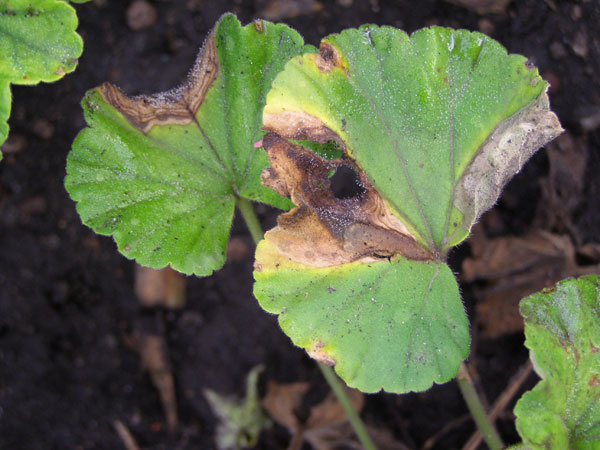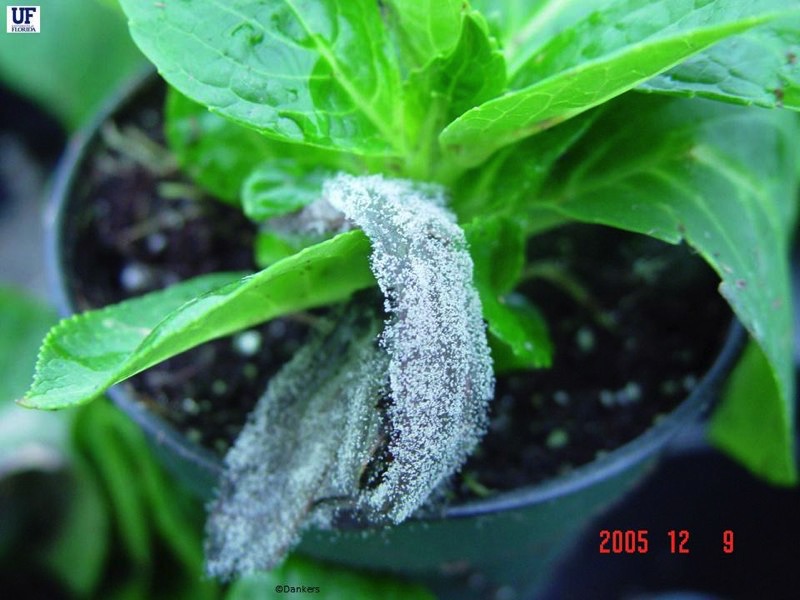April Showers Bring … Botrytis Blight
By Janet Scheren, Fairfax Master Gardener

Botrytis blight on geranium leaf
Along with May flowers, April showers can also bring enough moisture and warmth to trigger the first signs of a gray mold that infects many of our herbaceous annual and perennial plants. Botrytis cinerea, commonly called botrytis blight, is a fungal disease that infects a wide range of ornamentals plants in our gardens as well as fruit and vegetables. All it takes is a few days of cool rainy spring or summer weather, typically between 59 and 77 degrees F, to activate spores of the pathogen that overwintered on dead plant tissue left in the garden from fall. It can infect a plant’s leaves, stems, flowers, seeds, seedlings or bulb — virtually the whole plant except its roots. The good news is that B. cinerea is a weak opportunistic pathogen that mostly attacks stressed or weakened plants. So start with healthy plants and increase plant vigor to avoid this creeping gray velvet blight.
Marigolds, zinnias, roses anemone, begonia, calendula, chrysanthemum, dahlia, geranium, hydrangeas, sunflower and zinnia are among the flowering plants often affected. B. cinerea can also infect asparagus, beans, beets, carrots, crucifers, cucurbits, grapes, lettuce, onions and other alliums, peppers, potatoes, raspberries, tomatoes and many others.

Botrytis Blight on Strawberry
Be on the Lookout
Fortunately, most of us who take the time to plant a garden like to visit it frequently — even daily — to stop and enjoy its wonders. This also provides the opportunity to look for signs of disease. You’ll want to examine any brown or spotted plant material and look for masses of silver-gray spores on affected tissue. You may also see tiny black resting structures called sclerotia, but not all species of botrytis create them.
Cultural Practices to the Rescue
The best way to minimize the risk of botrytis blight and manage an outbreak is through cultural practices.
Too much water or too much fertilizer can actually encourage botrytis blight. Water and fertilize plants only as needed. Avoiding excess watering and watering at the roots minimizes the access to water that the pathogen needs to reproduce, germinate and spread. You will also want to ensure that you allow room for air circulation around your plants, so they can dry off quickly after rain. Providing that extra space between plants also makes it a little harder for the pathogen to spread. Think of it as social distancing in your garden, a concept we are all now familiar with.

Botrytis cinereae on hydrangea
Remove diseased tissue as soon as you see any signs of botrytis blight. This includes removing the whole plant, if needed. But often you’ll just need to prune away infected leaves, stems or blossoms. You will also need to wipe garden tools with a 70 percent solution of alcohol if they come in contact with diseased tissue. Infected tissue should be placed in the trash to be burned and not recycled into the landscape. Be sure to clean out each garden bed at the end of the season, removing any plant remnants and roots that have been affected by this or any other disease.
Use crop rotation strategies to prevent any soilborne pathogens from overwintering and infecting your next planting cycle. Make it a practice to move plants around and plant a different flower in that spot the next season. While crop rotation won’t entirely eliminate the problem, it helps avoid inoculum build-up in a bed and makes it easier for healthy plants to resist contamination in the future.
Biological Controls
Look for disease resistant plant species and cultivars if you’ve had trouble with botrytis blight. For example, my seed order this year focused on disease resistant varieties of basil and zinnias, two plants that were infected last year. At a minimum, avoid those varieties that are very prone to pathogen attack. You’ll also want to ensure you have healthy soil, full of beneficial microbes. VCE notes that using composted green waste and other organic matter enhances naturally occurring beneficial microbes already in the soil.
The Last Resort
VCE reports that cultural practices are more efficient in controlling Botrytis than any other fungal disease. Also keep in mind that, like overuse of antibiotics in human disease, using the same fungicide repeatedly can make the target pathogen resistant. This is particularly true with Botrytis blight, which is very prone to developing resistance. As a result, VCE recommends alternating treatments with different modes of action if you must resort to chemical control. Fungicides containing mancozeb and thiophanate methyl can be used in the home landscape on ornamentals. Beyond this, you will need to consult Virginia Cooperative Extension’s Pest Management Guide, as each fungicide is registered for use on different plants or groups of plants. What works on green beans is not the recommended treatment for grapes, for example. When using a chemical control, always fully read and follow labeling directions, especially the number of times a given fungicide can be used per season.
Peonies and Tulips
Not all botrytis blight is caused by B. cinerea. Two other common strains, B. paeonaie and B. tulipae, have strict preferences for the plants they are named after — peonies and tulips. Armed with this knowledge, you’ll want to keep best cultural practices in mind when siting and caring for these beautiful additions to the garden.
Resources
• Botrytis Blight: Botrytis cinerea; Botrytis spp., Cornell University, College of Agriculture and Life
Sciences
• Online Guide to Grapevine Diseases, Botrytis Bunch Rot and Blight, Ashley L. Myers, Grape Pathology
Extension Specialist, Department of Plant Pathology, Physiology, and Weed
Sciences, Virginia Tech, AHS Agricultural Research and Extension Center, Winchester, VA
• Home Ornamentals: Control of Ornamental Diseases, Home Grounds and Animals, 2021, Virginia
Cooperative Extension, Chuan Hong, Extension Plant Pathologist, Hampton Roads AREC
• Fire or Botrytis Blight of Tulip, Mary Ann Hansen, Extension Plant Pathologist, Department of Plant
Pathology, Physiology and Weed Science, Virginia Tech
• Botrytis Blight of Peony, Mary Ann Hansen, Extension Plant Pathologist, Department of Plant
Pathology, Physiology and Weed Science, Virginia Tech